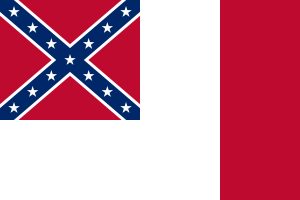아메리카 연합국의 국기
|
| |

| |
| 이름 | 성강기(星杠旗, The Stars and Bars) |
|---|---|
| 용도 | 7개의 별이 있는 아메리카 연합국의 첫 번째 국기 |
| 비율 | 5:9 |
| 채택일 | 1861년 3월 4일 |
| 요소 | 적, 백, 적의 3개 가로줄과 푸른 바탕에 흰 별이 놓인 칸톤 |

| |
| 이름 | 결백기(潔白旗, The Stainless Banner)[a] |
| 용도 | 아메리카 연합국의 두 번째 국기 |
| 비율 | 1:2 |
| 채택일 | 1863년 5월 1일 |

| |
| 이름 | 혈조기(血條旗, The Blood-Stained Banner) |
| 용도 | 아메리카 연합국의 세 번째 국기 |
| 비율 | 2:3 |
| 채택일 | 1865년 3월 4일 |
아메리카 연합국, 소위 남부맹방의 국기는 1861년에서 1865년 사이에 두 번 바뀌어 세 개가 존재한다.
미국 남북전쟁이 끝난 뒤에도 남부맹방과 관련된 기들은 미국 곳곳에서 다양한 맥락으로 사용되었다. 옛 미시시피주의 주기가 칸톤에 남부맹방의 육군 군기를 포함하고 있었으며, 조지아주의 주기는 남부맹방의 첫 번째 국기와 매우 유사하다.
다른 기
[편집]-
육군 군기
-
함수기(1861년 ~ 1863년)
-
함수기(1863년 ~ 1865년)
-
함미기(1863년 ~ 1865년)
-
국기(1861년 3월 ~ 5월)
함미기(1861년 ~ 1863년) -
국기(1861년 5월 ~ 7월)
-
국기(1861년 7월 ~ 11월)
아메리카 연합국의 국기에서 영향을 받은 기
[편집]맹방기
[편집]
기 및 문장 위원회 의장이던 윌리엄 포처 마일즈가 설계한 이 기는 1861년 당시 국기로 채택되지 못했지만 현재는 오히려 남부맹방을 상징하는 기로 통용되고 있다.
국기 선정에서 탈락된 뒤 이 기는 로버트 리 장군의 북버지니아군 군기로 채택되었다.[8] 미국 정부의 입장은 남부맹방을 국가가 아닌 반란세력으로 취급하기에 "국기" 같은 것도 인정할 수 없지만, 이 기를 흔히 맹방기(the Confederate Flag)라고 부르며, 미국 남부의 상징으로 자리잡았다.[9] 그 외에도 반란기(rebel flag), 딕시기(Dixie flag), 남부십자기(Southern cross)로 불린다. 성건기(The Stars and Bars)라는 별명도 있는데, 이는 원래 디자인이 전혀 다른 첫 번째 국기의 이름이다.[10]
논란
[편집]남부맹방의 기는 현재까지도 미국 남부 지역에서 흔하게 사용되고 있으나, 이 지역이 노예제를 유지한 역사적 배경으로 인해 아프리카계 미국인과 민권 운동가를 비롯한 몇몇 계층 사이에서는 인종 차별과 백인 우월주의의 상징으로 여겨지고 있다. 이 때문에 논란이 되고 있으며, 특히 2015년 찰스턴 교회 총격 사건, 2020년 조지 플로이드 시위 등의 여러 사건이 발생한 이후에는 곳곳에서 퇴출 운동이 벌어지고 있다.[11]
같이 보기
[편집]각주
[편집]- 내용주
- 참조주
- ↑ Preble, George Henry (1872). 《Our Flag: Origin and Progress of the Flag of the United States of America》. Albany, New York: Joel Munsell. 414–417쪽. OCLC 423588342. 2015년 3월 26일에 확인함.
- ↑ Preble, George Henry (1880). 《History of the Flags of the United States of America: Second Revised Edition》. Boston: A. Williams and Company. 523–525쪽. OCLC 645323981. 2015년 3월 26일에 확인함.
- ↑ Coski, John M. (2013년 5월 13일). “The Birth of the 'Stainless Banner'”. 《The New York Times》. New York: The New York Times Company. 2014년 1월 27일에 원본 문서에서 보존된 문서. 2014년 1월 27일에 확인함.
A handful of contemporaries linked the new flag design to the "peculiar institution" that was at the heart of the South's economy, social system and polity: slavery. Bagby characterized the flag motif as the "Southern Cross" – the constellation, not a religious symbol – and hailed it for pointing 'the destiny of the Southern master and his African slave' southward to 'the banks of the Amazon,' a reference to the desire among many Southerners to expand Confederate territory into Latin America. In contrast, the editor of the Savannah, Ga., Morning News focused on the white field on which the Southern Cross was emblazoned. "As a people, we are fighting to maintain the heaven-ordained supremacy of the white man over the inferior or colored races. A White Flag would be thus emblematical of our cause." He dubbed the new flag "the White Man's Flag," a sobriquet that never gained traction.
- ↑ Thompson, William T. (1863년 4월 23일). “Daily Morning News”. Savannah, Georgia.
- ↑ Thompson, William T. (1863년 4월 28일). “Daily Morning News”. Savannah, Georgia.
- ↑ Thompson, William T. (1863년 5월 4일). “Daily Morning News”. Savannah, Georgia.
- ↑ Loewen, James W.; Sebesta, Edward H. (2010). 《The Confederate and Neo Confederate Reader: The Great Truth about the 'Lost Cause'》. Jackson, Mississippi: University Press of Mississippi. 13쪽. ISBN 978-1-60473-219-1. OCLC 746462600. 2013년 12월 13일에 원본 문서에서 보존된 문서. 2013년 12월 5일에 확인함.
Confederates even showed their preoccupation with race in their flag. Civil War buffs know that 'the Confederate flag' waved today was never the official flag of the Confederate States of America. Rather, it was the flag of the Army of Northern Virginia. During the war, the Confederacy adopted three official flags. The first, sometimes called 'the Stars and Bars,' drew many objections 'on account of its resemblance to that of the abolition despotism against which we are fighting,' in the words of the editor of the Savannah Morning News, quoted herein.
- ↑ Geoghegan, Tom (2013년 8월 30일). “Why do people still fly the Confederate flag?”. 《BBC News》. 2013년 10월 30일에 확인함.
- ↑ Chapman, Roger (2011). 《Culture Wars: An Encyclopedia of Issues, Viewpoints, and Voices》. M.E. Sharpe. 114쪽. ISBN 978-0-7656-2250-1. 2013년 2월 21일에 확인함.
- ↑ (Coski 2005, 58쪽)
- ↑ “'인종주의 논란' 남부연합기, 갈등진앙서 퇴출(종합)”. 2017년 4월 18일에 확인함.








